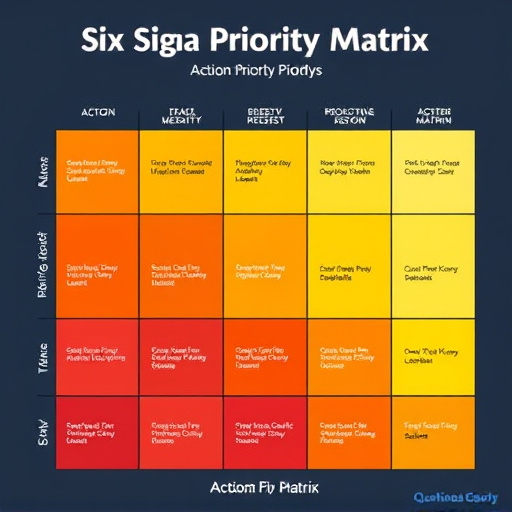The Six Sigma Action Priority Matrix is a strategic framework that helps teams prioritize tasks by categorizing them into four quadrants based on urgency and importance, optimizing resource allocation, and accelerating project timelines. This tool guides projects to focus on high-impact initiatives, manage competing actions, and meet customer expectations, ultimately driving successful Six Sigma outcomes by maximizing efficiency and reducing defects.
In the pursuit of excellence through Six Sigma projects, prioritizing actions is paramount. The Six Sigma Action Priority Matrix serves as a powerful framework to focus efforts on high-impact tasks. This article delves into the intricacies of this matrix, guiding you through identifying critical activities, evaluating urgency and importance, optimizing resource allocation, and continuously refining priorities for long-term success. By mastering the art of action prioritization, organizations can maximize their Six Sigma initiatives’ potential.
- Understanding the Six Sigma Action Priority Matrix: A Framework for Focus
- Identifying Critical Tasks: Defining High-Impact Activities
- Evaluating Urgency and Importance: Prioritizing Based on Impact
- Balancing Resources and Time: Effective Allocation for Maximum Results
- Continuous Improvement: Refining the Matrix for Long-Term Success
Understanding the Six Sigma Action Priority Matrix: A Framework for Focus

The Six Sigma Action Priority Matrix is a powerful framework that helps project teams focus their efforts on the most critical tasks. This matrix categorizes actions into four quadrants based on urgency and importance, allowing for a structured approach to decision-making. By understanding these quadrants—High Urgency/High Importance, High Urgency/Low Importance, Low Urgency/High Importance, and Low Urgency/Low Importance—teams can prioritize initiatives that bring the greatest value and impact. This strategic sorting ensures resources are allocated efficiently, accelerating project timelines and enhancing overall effectiveness.
This matrix serves as a guiding tool for navigating complex projects, where numerous actions compete for attention. It encourages teams to consider not just what needs to be done but also what will have the most significant effect. By prioritizing actions according to this framework, Six Sigma projects become more manageable, focused, and ultimately, more successful in achieving their reduction of defects and improvement goals.
Identifying Critical Tasks: Defining High-Impact Activities

In any Six Sigma project, identifying critical tasks is a pivotal step. The process begins by assessing all project activities and assigning them a priority level using tools like the Six Sigma Action Priority Matrix. This matrix categorizes tasks based on their urgency and impact on the overall goal, ensuring that high-value activities receive immediate attention. By focusing on these critical tasks first, teams can maximize efficiency and significantly reduce time to value.
Each task is evaluated based on criteria such as customer impact, project dependency, and resources required. High-impact activities are those that have a substantial effect on improving processes or meeting customer expectations. Prioritizing these tasks ensures that efforts are concentrated where they matter most, leading to more effective problem-solving and successful project outcomes.
Evaluating Urgency and Importance: Prioritizing Based on Impact

In any Six Sigma project, evaluating the urgency and importance of tasks is a critical step in decision-making. The Six Sigma Action Priority Matrix provides a structured approach to assess the impact and urgency of each action item, ensuring resources are allocated efficiently. This matrix helps teams identify which problems require immediate attention and which can wait.
Prioritizing based on impact means focusing on actions that will have the most significant positive effect on the project’s overall success. Tasks that address critical defects or bottlenecks should be prioritized higher than those with less substantial impacts. By ranking actions based on their potential to drive change, Six Sigma teams can ensure they are making progress on the most meaningful fronts, ultimately leading to more effective problem solutions and process improvements.
Balancing Resources and Time: Effective Allocation for Maximum Results

In Six Sigma projects, balancing resources and time is a delicate art that can make or break the project’s success. The Six Sigma Action Priority Matrix serves as a powerful tool to manage this balance, helping teams allocate their time and resources efficiently. By evaluating tasks based on urgency and importance, the matrix ensures that critical actions are addressed first while less urgent but still valuable tasks receive timely attention.
This strategic approach prevents a situation where too much focus is given to minor details while significant aspects of the project gather dust. Effective resource allocation enabled by the Action Priority Matrix leads to optimized outcomes, ensuring that every hour and every dollar invested in the Six Sigma initiative delivers maximum impact.
Continuous Improvement: Refining the Matrix for Long-Term Success

In the pursuit of continuous improvement, a critical tool in any Six Sigma project is the Six Sigma Action Priority Matrix. This matrix serves as a strategic framework for organizing and prioritizing actions based on their urgency and impact. By categorizing tasks into quadrants, teams can efficiently allocate resources, ensuring that efforts are focused on high-value activities. This refining process allows organizations to continuously enhance their processes, products, and services over the long term.
The matrix encourages a balanced approach where immediate issues are addressed while also considering future strategic goals. Prioritizing actions in this manner fosters a culture of sustained improvement, enabling businesses to stay competitive and adaptable in today’s dynamic market. Effective utilization of the Six Sigma Action Priority Matrix ensures that every step taken contributes to overall project success and fosters a more efficient, effective operational landscape.
Prioritizing actions is a cornerstone of successful Six Sigma projects. By utilizing the Six Sigma Action Priority Matrix, organizations can effectively focus on critical tasks that drive significant impact. Balancing urgency and importance ensures resources are allocated efficiently, maximizing project outcomes. Continuous improvement of this matrix over time fosters long-term success by adaptively addressing evolving business needs and ensuring every initiative contributes to optimal process performance.
